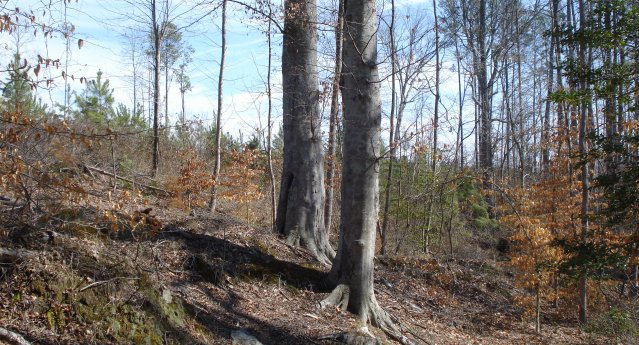We are all excited that natural communities offset some of the carbon emitted by burning fossil fuels, but we have to put it all in context. We have to recall that carbon offset is only one of the thousands of ecological services performed by natural communities. I will say more about that below, but let’s start with the carbon.
Below is construction on a Hot-Lane interchange on I 495. This area used to be covered with trees. We traded trees for travel time. Everything we do is a tradeoff. We should just be sure we know what trades we are making and make them well. More on congestion pricing at this link.
Carbon is as necessary to life as oxygen. Growing plants covert carbon dioxide to biomass and release it when they decompose or respire and this cycle has been going on for billions of years. The processes have been roughly in balance.

They have to be; otherwise all the carbon would have been used up billions of years ago and life on earth would have perished. This explains why a mature ecosystem absorbs little carbon dioxide. And this is the problem with offsets. An established old growth forest doesn’t remove much carbon from the atmosphere. A rapidly growing new forest soaks up a lot of carbon, and that is what we are growing now, but eventually it becomes a mature forest. In the short run, offsets can compensate for a small percentage of industrial CO2 emissions but in the long run carbon absorption will balance carbon release.
The USDA has a good online calculator for how much carbon is sequestered in various types of forests. Forests can sequester carbon in the branches, roots, soils and understory of living forests, as well as long-lived wood products (the wood that in your house will be around a long time.) Offsets will buy us some time and they are worth doing for that reason alone, but there are lots of other reasons to preserve natural lands and maintain the ecological services they provide.
Below is a clearcut. This was covered by a mixed hardwood forest and I don’t know why the owner decided to slick off the trees. I don’t like it, but it is not my business and this is not necessarily the end of the forest. It can be replanted or grow back naturally, unless it is coverted to other uses. By the end of the summer, this bare ground will be covered with vegetation and provide good wildlife habitat. In three years, it will be ideal bobwhite quail habitat, for example. It looks really ugly to human eyes, however.

Don’t it always seem to go that you don’t know what you’ve got ‘till it’s gone
We are used to getting ecological services for free or by imposing costs on others. Economists call them externalities. Among ecological services these include things like carbon, sediment removal, water, air, biodiversity, open space and natural beauty. But it’s getting harder to get these things free and others are increasingly unwilling or unable to provide them as a public service and we are facing a tragedy of the commons. By 2025 Virginia will probably welcome 3 million new residents and we are projected to lose a million acres of forest land to development. (When a forest is harvested, it can grow back. When it is converted to other uses, such as homes or parking lots, it is lost for a long time or essentially forever.) As our populations grow and demands increase, it becomes clearer that we have to find prices for these priceless goods. Otherwise they will continue to be wasted and abused.
Markets can handle risk, but they do less well with uncertainty. A market in ecological services requires a lot of the same things as other markets. It is harder in the ecological services market because definitions and measurements are difficult. Any measures have to be science-based and compatible with regulations. Beyond that, markets thrive when transaction costs are low; rules are clear; there are credible measures; an adequate number of buyers and sellers and – perhaps most important , trust – trust that contracts will be honored, goods and services will be more or less as represented and trust that markets will persist for a reasonable amount of time.
Below are mature beech trees in front of a new pine forest. This is great wildlife habitat, since it combines old woods, young woods and ground vegetation.

Given the unusual nature of ecological service, the dominance of regulation and the need for a long-lived authority to define products and enforce agreements, there is a useful role for government to jump start the creation of a such a market. Section 2709 of the new Farm Bill gives the USDA the responsibility to study and foster markets for ecosystem services. In our region we also have things like the Bay Bank.
Markets are usually the best way to aggregate information, allocate resources and organize diverse needs and contributions. Now is an exciting time for ecological services markets. This is how it looks at the early stages of a market formation. There are lots of entrants, a plethora of good ideas and chaos. We have to tolerate ambiguity, while reducing it. From all this ferment I am sure solutions will come.

